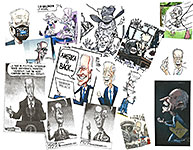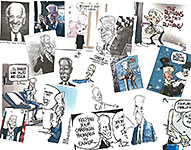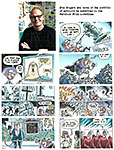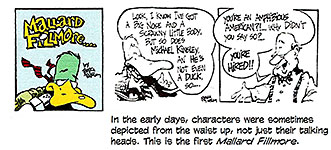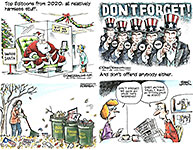 |
||||||||||||||||
Opus 415 (March 17, 2021). Our Political Posting— nearly 100 of the past month’s editoons reviewed, plus six Dr. Seuss cancelled, new Presidential caricatures, the most popular editoons of 2020, newspaper chain drops the duck strip, Cuomo and the Gotcha Culture—and more, much more. Here’s what’s here, by department, in order (the longest entries are marked with an asterisk* a reader’s guide to help you decide where to spend your time)—:
*Six Seuss Cancelled Other Cancellations—Aunt Jemima, Pepe Le Pew, Babar, Winnie the Pooh et al No Comic-Con at Sandy Eggo This Summer
TRUMPERIES The Antics and Idiocies of Our Bloviating Buffoon in Chief EDITOONERY The Mock in Democracy **Nearly 100 Editoons Discussed, Plus—: My Ragged & Funny Songbook Cover Cuomo and the Gotcha Culture
NEW PRESIDENTIAL CARICATURE How It’s Done
Rob Rogers Gets the Herblock Prize Newspaper Chain Drops the Duck Strip The Most Popular Editoons of the Year 2020 Rush Limbaugh’s Place In Political History
QUOTE OF THE MONTH If Not of A Lifetime “Goddamn it, you’ve got to be kind.”—Kurt Vonnegut Our Motto: It takes all kinds. Live and let live. Wear glasses if you need ’em.
But it’s hard to live by this axiom in the Age of Tea Baggers, so we’ve added another motto: Seven days without comics makes one weak. (You can’t have too many mottos.)
And in the same spirit, here’s—: Chatter matters, so let’s keep talking about comics. AND—
“If we can imagine a better world, then we can make a better world.”
And our customary reminder: don’t forget to activate the “Bathroom Button” by clicking on the “print friendly version” so you can print off a copy of just this installment for reading later, at your leisure while enthroned. Without further adieu, then, here we go—:
Dr. Seuss Cancelled MULBERRY STREET AND FIVE OTHER SEUSS BOOKS CANCELLED Called “Hurtful” What Unadulterated Horse Shit IT SEEMS ALTOGETHER FITTING that in our first post-presidential Trumpet posting devoted to editorial cartooning we have a topic that excites reaction from editoonists—namely, the news that Dr. Seuss Enterprises will end publication and licensing of six books by Theodor Seuss Geisel. The titles include his first book writing under the pen name Dr. Seuss, And to Think That I Saw It on Mulberry Street (published in 1937) and If I Ran the Zoo (1950). The other four books are represented in the accompanying visual aid. “These books portray people in ways that are hurtful and wrong,” Seuss Enterprises said in the statement announcing the decision that came after working with a panel of experts, including educators, and reviewing its catalog of titles.
“Hurtful”? Hurtful. With that sniveling weasel word, Seuss Enterprises, the very body charged with preserving the Seuss legacy, begins decimating it. The cancel culture irony soars. Count me among the livid. Alas, not all of the editoonists represented in the adjoining display are opposed to cancel culture: Steve Breen (number 5) supports purifying Seuss, and Chris Britt (6) weighs the trivial number of discontinued titles against the total Seuss canon of 60+ and sees ten percent as not enough to get excited about. Well, today it’s ten percent; tomorrow, maybe fifteen—then thirty and then two thirds and so on to extinction. My advice: don’t give an inch. Most of the editoonists use Seuss characters to convey their messages. Rick McKee (1) uses a modified Cat in the Hat to ridicule a “woke” population that doubtless inspired the cancellation. The “other hat” here is the Pussy Hat, a name and a chapeau design chosen in part as a protest against vulgar comments the Trumpet made about the freedom he felt to grab women’s genitals: the idea was to de-stigmatize the word “pussy” and transform it into one of empowerment, and to highlight the design of the hat’s “pussycat ears.” Chip Bok (2) shows that Dr. Seuss is a victim of the same cancel culture effort that in California lobbies to change the name of a local school, eliminating the Abraham Lincoln part of the name because they claim he lived a racist life that “didn’t make it clear that black lives mattered to him.” Reporting this absurdity, Ryan James at Freedom Wire says, “so the man who liberated slaves, pushed for their right to vote, and was murdered by a white man for doing so is clearly a racist. ... Cancel culture keeps getting dumber and dumber. Their campaign to purify our national history and remake it in their Leftist vision continues. “That’s right,” James goes on, “old Honest Abe is not woke enough for the historical purists.” In case you haven’t noticed, the woke folk “represent a growing movement in this country: erase all the ugly episodes of our history. ... If the person wasn’t pure as the driven snow by today’s standards, then they should be eliminated from our civic discourse. History should be rewritten the way the social justice mob wants it.” James reminds us: “This whitewashing of history is similar to that of the classic novel 1984, where the ruling regime wants all unsavory aspects of the country’s past to be destroyed and rewritten to suit the narrative of the present.” Imagine: George Orwell overtaken by actual history. The photograph of a sculpture of Seuss at his drawingboard with the Cat in the Hat looking over his shoulder is part of our exhibit in order to remind us with this reference to the Dr. Seuss National Memorial Sculpture Garden in Springfield, Massachusetts, that Dr. Seuss is not just an author of children’s books: he’s an institution. Only institutions get statues. When we get to the fourth display, we encounter Dave Granlund’s Mark Twain (8), who takes the absurdity to the next level. And then we have the editpoets Matt Davies (9), Joel Pett (10) and Michael Ramirez (11), who manage decent approximations of Seussian verse to condemn the woke purists.
MULBERRY STREET HAS BEEN HIT BEFORE by the early woke, Jeva Lange reports in The Week, and in response, Seuss himself changed “Chinaman” to “Chinese man.” Lange quotes Seuss: "I had a gentleman with a pigtail. I colored him yellow and called him a 'Chinaman.’ That's the way things were 50 years ago. In later editions, I refer to him as a 'Chinese man.' I have taken the color out of the gentleman and removed the pigtail and now he looks like an Irishman." Seuss, who was a cartoonist before he was a children’s book author, can’t resist a satirical twist. Irishman indeed. But lately I think the problem is that the Chinese guy is drawn with slanted eyes. Geez. Don’t the Chinese and Japanese have “squintier” eyes that Caucasians? If so, why can’t that be depicted in a visual art?
But there are other problems. All Seuss’ books are “too white.” No other races are depicted (except unfavorably: Africans wearing grass skirts and hair sprouts that are funny). What’s next? Are we going to cancel the works of Charles Dickens because they’re “too white”? Are we going to blast Lincoln off Mount Rushmore because he hadn’t learned to chant “Black lives matter”? In If I Ran the Zoo, two characters from “the African island of Yerka” are depicted as shirtless, shoeless and resembling monkeys with hair sprouting out of their heads. The Cat in the Hat, although surviving the current purge, does not escape criticism. Katie Ishizuka, a cousin of the executive director of School Library Journal, points out that the Cat in the Hat, perhaps Seuss’ most famous character, is based on minstrel stereotypes. “The Cat’s physical appearance, including the Cat’s oversized top hat, floppy bow tie, white gloves, and frequently open mouth, mirrors actual blackface performers; as does the role he plays as ‘entertainer’ to the white family—in whose house he doesn’t belong,” says Ishizuka. Too much. A stretch too far. Idiocy running wild. Ridiculous approaching ludicrous. Deploying the Ishizuka method, we can find vestiges of minstrelsy anywhere we choose to look. Mickey Mouse, for instance, is clearly a perpetrator of the tradition. He wears white gloves. And he’s black. Mostly black. Actually, his face is white—a satirical reverse, whiteface instead of blackface. Obviously, a racist echo of a racist tradition. In March 2016, Ishizuka wrote a piece on the website Blavity about Seuss’ anti-Japanese cartoons, along with work that used the N-word and depicted blacks at a slave auction or rendered to resemble monkeys. She also pointed out images portraying Middle Eastern men as camel-riding sultans and women as hyper-sexualized harem dwellers. But what Ishizuka found even more troubling were racist images hidden in plain sight in Seuss’s popular picture books. Ishizuka, who holds a Master’s degree in social work, conducted a critical race analysis of 50 children’s books by Seuss and found that 98 percent of the human characters were white, and only two percent were people of color. In Ishizuka and Ramón Stephens' 2019 study, The Cat is Out of the Bag: Orientalism, Anti-Blackness, and White Supremacy in Dr. Seuss's Children's Books, of 2,240 human characters identified in Seuss' 50 children's books, only 2 percent were characters of color, and all of them were ‘depicted through racist caricatures.’” Jenny Gross at nytimes.com says: “The decision to stop the publication of some Dr. Seuss books helps revive a debate over classic children’s titles that do not positively represent minority groups. In France, the latest in a series of beloved comic books, Lucky Luke, features a Black hero and a narrative that reimagines the role of the cowboy, drawing criticism that the book was caving to an American-inspired obsession with race.” (The Black character is based upon Bass Reeves, an authentic African American Deputy U.S. Marshall in the Old West.) The Seuss purification effort has been met with a roiling outcry about "cancel culture" and book-banning from conservatives as well as some centrists and liberals worried about "politically correct" excesses, reports Cathy Young at The Week. “Others counter that there is no ‘cancellation,’ just a corporate decision to stop reprinting books that are jarringly dated due to evolving cultural attitudes (and that will remain widely available even without new editions).” And those widely available unaltered versions are already showing up on eBay with price tags in the thousands. Ceasing sales of the books makes them rarer, and counter-productively results in them becoming more valuable in the long run, says Lange. “A pre-revision 1937 copy of Mulberry Street for sale on Abe Books, for example, runs between $3,000 and $9,000. Additionally, many readers proudly boast about reading ‘banned’ or otherwise challenged books, which means terminating the publication of the Dr. Seuss books could potentially make them celebrated for the wrong reasons.”
BEFORE HE BECAME A GIANT of children’s literature, Gross reports, Geisel drew political cartoons for a New York-based newspaper, PM, from 1941 to 1943. Some of the editoons used racial stereotypes to caricature Japanese and Japanese-Americans with slits for eyes, Blacks in grass skirts, and so on. Decades later, Geisel said he was embarrassed by the cartoons, which he said were “full of snap judgments that every political cartoonist has to make.” To which I inject: not so much “snap judgments”: editorial cartoonists traffic in visual shorthand, pictorial stereotypes that quickly convey ideas. Geisel was scarcely the only editoonist to deploy such racial stereotypes. In fact, during the period he was working as a political cartoonist—that is, during World War II— virtually the entire brotherhood was caricaturing the Japanese with squinty eyes and protruding buck teeth. It was a conventional (albeit benighted) way of cartooning “Asians” then, and, since the Japanese were our enemy (having bombed Pearl Harbor without warning on December 7, 1941), it demonized them, which is what every medium was doing in those times of war. Blatant anti-Japanese racism that was a staple of U.S. war propaganda. You can’t escape the culture you’re immersed in. We’ve posted examples of the wartime Japanese racial stereotype in this vicinity, beginning with Seuss’s versions.
As you can see, he was scarcely alone in demonizing the Japanese. And the Germans.
YOUNG INTRODUCES a suspicious eddy in the current stream of accusation. “The critique of those ‘racial undertones’ has been often tendentious to the point of distortion. Thus, a CNN article asserts that Geisel, erstwhile political cartoonist, "had a long history of publishing racist and anti-Semitic work, spanning back to the 1920s when he was a student at Dartmouth College. There, Seuss once drew Black boxers as gorillas and perpetuated Jewish stereotypes by portraying Jewish characters as financially stingy." He also wrote a minstrel show and performed it in blackface, Taylor Telford reports at washingtonpost.com. No mention is made of the fact that by the 1940s, the cartoonist had emerged as an outspoken foe of anti-Semitism — a stance that would later earn him the title of "honorary Jew," bestowed by Jerusalem mayor Teddy Kollek in 1969 — and of anti-Black racism. A 1942 cartoon skewered racial discrimination in U.S. war industries: an entrance for "Negro job-hunters" is shown leading to an impenetrable maze. In later years, Geisel’s children's books often served as parables denouncing racial prejudice and xenophobia. Horton Hears a Who, written after a visit to Japan, famously declared, "A person's a person, no matter how small," and was dedicated to a Japanese friend, Mitsugi Nakamura. So: should the six discontinued books be in the classrooms or home libraries of very young children? Definitely not, says Lange. “Kids begin forming racial biases as young as 3 [years old] and ‘by the age of 7, those biases become fixed,’ NPR reports. We also know that children's development can be harmed by seeing negative depictions of themselves in the media. “A better approach, then, would be continuing to publish the six books in question, but supplement the editions with historical context and teaching materials. It's a method Disney and Warner Bros have taken when presenting the works in their catalogs that likewise perpetuate harmful stereotypes.” Yes, a better approach.
SEUSS’ PURPOSE in writing his books for children was to entertain them. Mostly. His racist pictures are quite incidental to his underlying motives. It’s certain that he didn’t intend to belittle or ridicule the races he depicted. Then why punish him for something he didn’t do? I object to dead people’s reputations being destroyed because they don’t live up to the ideals we’ve formulated since they died. That seems rampantly juvenile. A friend of mine, documentary filmmaker Tom Tanquary, agrees that the Seuss thing is blown way out of proportion. “There's a vast difference between outright racism and cultural insensitivity,” he said. “Seuss wasn't trying to harm Asians or Blacks in any direct way. Of course, today no one would draw caricatures like that or so many other depictions common from his time. Having a disclaimer on the book is about as far as I'd go. Taking them out of print is ridiculous. “At some point this all has to stop,” he continued. “Yes, point out bad behavior but don't cancel people for it. Sometimes the dog pees on the rug. Doesn't mean you put it down. You just find a way to modify the behavior or just protect against the effects. Like banning tDump from twitter, or the dog from the living room.” My solution for Seuss Enterprises is simple: change the offending text and/or pictures. Eliminate everything “Chinese” about the “Chinese” guy in Mulberry Street. Fix his eyes, take out his rice bowl and chopsticks. Dress the Africans in more conventional garb—shorts and a t-shirt. And give them good haircuts. Seuss purists doubtless would object to this solution. Seuss books are sacred to them, and they should not be tampered with. So rather than tamper, they simply censor them out of existence? You can’t have it both ways: if something is sacred, then it can’t be censored. But if it can be censored, then it can be altered or adjusted. Sprinkle a little brown color on the white faces throughout the Seuss oeuvre. Why not? That wouldn’t affect the essential charm of the works. And that, after all, is what we’d like to preserve, right? Oh, well. They didn’t ask me.
AND NOT ONLY DR. SEUSS BUT ... Huge chunks of popular culture are being swept away in the fever of correcting our history. Aunt
Jemima pancake mix is changing its name and logo after 130 years of using a
Black woman as the staple feature of the product’s marketing. The brand's
parent company PepsiCo acknowledged the name and image was ingrained in racist
symbolism based on the enslaved “Mammy” archetype. Henceforth, the brand
will be denominated the Pearl Milling Company, the original Missouri business
that in 1889 introduced an instant pancake mix under the Aunt Jemima name. Food giant Mars said it's changing the name of its Uncle Ben's Rice. Boxes of the rice product used to picture Uncle Ben, a Black man; he’s now gone, and the rice’s new name is just Ben’s Rice. With Jemima and Uncle Ben gone, Conagra Brands announced it has “begun a complete brand and packaging review on Mrs. Butterworth's syrup.” In debates over Mrs. Butterworth’s race, some have associated the shape of the brand’s syrup bottles with the offensive "Mammy" racial caricature for Black women although Conagra said its syrup packaging is “intended to evoke the images of a loving grandmother.” The name Eskimo Pie, the chocolate-covered ice cream treat that has been around for nearly a century, will soon be retired. Dreyer’s Grand Ice Cream, which owns the dessert, plans to have a new name by the end of the year and will discontinue Eskimo, a term commonly used in Alaska to refer to all Inuit and Yup’ik people but it is considered derogatory by many who associate it with racist, non-Native colonizers who settled in the Arctic and used the term incorrectly. Moves to correct dated or offensive cultural material take different forms. NASCAR has banned the Confederate battle flag. HBO Max has temporarily shelved the film “Gone with the Wind” over its glorification of the antebellum South. Turner Classic Movies has introduced “Reframed: Classic Films in the Rearview Mirror,” a series devoted to “problematic” films. TCM has identified 17 films that will be discussed, among them, “Gone With the Wind,” “Guess Who’s Coming to Dinner,” “Tarzan,” “Breakfast at Tiffany’s,” “The Searchers” and “Psycho.” I get it with most of these, but “Breakfast at Tiffany’s”? What is it with jewelry? Over at Warner Bros Looney Tunes, Pepe Le Pew is in trouble for his ravenous pursuit of women (with rape on his mind) and Speedy Gonzales for helping to popularize the corrosive stereotype of the drunk and lethargic Mexican. Pepe the lecherously predatory skunk is likely to be a thing of the past in all media. The verdict is still out for Speedy. Cartoonist and animation writer-producer Lalo Alcaraz whose syndicated comic strip La Cucaracha is Latino themed, isn’t offended by Speedy, the sombrero-wearing “fastest mouse in all Mexico.” Said Alcaraz: “Cartoons like Speedy Gonzales still resonate with people llike me. As a Mexican American child growing up along the border, I rarely saw representations of Mexicans or Mexico, and when they appeared, they were always super-negative. Speedy was like a superhero, who outran the gringo cat and redistributed the cheese to the hungry mice. “He wasn’t lazy or shiftless,” Alcaraz concluded. “He was the fastest, most lovable mouse in all of Mexico. I can’t even tell you want Mickey Mouse does or what his personality is.” Disney Plus recently removed such films as “Peter Pan” and “Dumbo” from its set of titles because of stereotypes and racist depictions. One of the highlights in “Dumbo” is a scene featuring a flight of crows who talk in Black dialect. The show runner for HBO Max’s “Looney Tunes Cartoons” said “we’re not doing guns,” which means Elmer Fudd no longer carries his hunting rifle when out hunting Bugs Bunny and Yosemite Sam is stripped of his pistols. Martin Gitlin, co-author of A Celebration of Animation: The 100 Greatest Cartoon Characters in Television History, thinks character changes are troublesome. “I consider myself as progressive as they come, but sometimes I fear that cancel culture will eventually cross over into the realm of ridiculous.” Andrew Farago, curator at San Francisco’s Cartoon Art Museum and author of The Looney Tunes Treasury, disagrees. “It’s not ‘cancel culture run amok,’ as some news outlets and their audiences will tell you,” he says. “This is just the beginning of the conversation.” Children and young adult books have been challenged for decades because people want to protect children from “inappropriate” sexual content or “offensive” language. In fact, the top three reasons cited for challenging materials as reported to the Office of Intellectual Freedom are: --the material was considered to be "sexually explicit" --the material contained "offensive language" --the materials was "unsuited to any age group"
But sometimes, it’s hard to see the nature of the complaint. The Giving Tree was banned from a public library in Colorado in 1988 because it was interpreted as being sexist. Some readers believe that the young boy continually takes from the female tree, without ever giving anything in return. As the boy grows up, he always comes back to the tree when he needs something, taking until the tree has nothing left to give him. Readers objected to Maurice Sendak’s Where the Wild Things Are because they believed the book to be psychologically damaging and traumatizing to young children due to Max’s inability to control his emotions and his punishment of being sent to bed without dinner. Psychologists called it “too dark”, and the book was banned largely in the south. It has also been challenged several times for its images of witchcraft and supernatural elements. Babar also got in trouble. Babar is a fictional elephant character who first appeared in 1931 in the French children's book Histoire de Babar by Jean de Brunhoff and subsequently translated into English. It tells of a young elephant, named Babar, whose mother is killed by a hunter. Babar escapes, and in the process leaves the jungle in exile, visits a big city, and returns to bring the benefits of civilization to his fellow elephants. Just as he returns to his community of elephants, their king dies from eating a bad mushroom. Because of his travels and civilization, Babar is appointed king of the elephant kingdom. He marries his cousin, and they subsequently have children and teach them valuable lessons. Some writers have argued that, although superficially delightful, the stories can be seen as a justification for colonialism. Babar's Travels was removed from the shelves by library staff in East Sussex in response to parental complaints for what was perceived as stereotypes of Africans. Winnie the Pooh got a bad rep because some people see talking animals as somehow an "insult to god," so this book has been banned throughout random parts of the United States. Several institutions in Turkey and the UK have also banned the book, claiming that the character of Piglet is offensive to Muslims. Other institutions claim that the book revolves around Nazism. My favorite concerns Alice in Wonderland. Apparently there are references to sexual fantasies and masturbation in the book, resulting in its ban from classrooms in New Hampshire. Since this original banning, the book has been challenged by thousands of other institutions, most famously in the 1960s for fear that it would promote drug use to children. At least sexual fantasies and masturbation are safe.
SOMEONE, thinking, no doubt, of the Trumpet, quoted this happy relic—: "Yesterday upon the stair I met a man who wasn’t there He wasn’t there again today I wish, I wish he’d go away"
This Just In (As They Say)—: NO COMIC-CON AT SANDY EGGO THIS SUMMER This came over the transom on March 12: Comic Con International announced that 2021 will see July’s San Diego Comic-Con taking place in the virtual space again, as the World Health Organization cautions against premature relaxing of COVID-19 mitigation restrictions. A smaller in-person event is planned for November, but 8 months is a long time in virology, and CCI notes that multiple event postponements have left the organization with “limited financial resources,” so I’d be willing to predict we’ll see some smaller/mid-level events faced with the decision to go ahead and take place in unsafe settings or be bankrupted by venue cancellation penalty clauses while trying to maintain liquidity through ticket/table sales. Sorry: dunno who the “I” is. But here’s the Official Announcement from CCI, verbatim, it includes some informative details not mentioned above—:
As you may be aware, due to concern for public health and safety, San Diego Comic Convention had to cancel both of its in-person events in 2020 and recently announced that our spring 2021 show, WonderCon in Anaheim, will also be canceled. In its place, WonderCon@Home will once again be held as a free online event on March 26 and 27, 2021. It is the policy of the organization to continue to closely monitor information from local and national healthcare officials as it pertains to the COVID-19 pandemic. Never could we have imagined what the world experienced in 2020 and continues to experience today. While we are buoyed by the rollout of the vaccine and the growing number of individuals being inoculated, it appears that July will still be too early to safely hold an in-person event of the magnitude of Comic-Con. For this reason, we have made the challenging decision to postpone Comic-Con 2021 as an in-person gathering until our 2022 dates, and once again hold this year's celebration as the free online Comic-Con@Home. Unfortunately, the challenges of this past year and the multiple postponements of our two largest events have left us with limited financial resources, so this year the online experience will be reduced to a three-day event, spanning July 23-25, 2021. While we lament the postponement of the in-person Comic-Con, our commitment to this community of fans and our celebration of comics and the related popular arts endures as an important part of who we are. As the timing and scope of our larger event factored greatly into our decision to postpone, we believe that launching a smaller in-person event at a later time may be a safe alternative. For this reason, we are happy to announce that San Diego Comic Convention is planning to present a three-day in-person convention in San Diego in November. At this time, we are still working on specific details as to attendance capacity, badge cost, and related information, and those details will be forthcoming. Please continue to visit our website, comic-con.org, for official updated information as it becomes available. At this time, individuals who have purchased badges that were rolled over to the 2021 show will have those badges automatically transferred to the 2022 event unless a refund is requested. To submit a badge refund request, visit www.comic-con.org/cci/comic-con-cancellationrefund-policy. All confirmed exhibitors with a rollover payment from Comic-Con 2020 will receive a separate email with instructions and deadlines for continuing to forward your payment on to Comic-Con 2022, or for requesting a refund. In addition, we are currently working on an option for those wishing to transfer their badge or exhibitor deposits/payments as full or partial payment towards our 2021 November event. Information will be forthcoming, so please watch your email inbox and the Comic-Con website for further details. The past several months have taken a great toll on both families and friends, and we hope this effort is a small move toward a return to gathering as a community to not only celebrate popular art, but also friendship, education, and the enduring spirit of the fandom that is so much a part of Comic-Con. We thank you all for your continued and unwavering support during these most challenging times. We look forward to seeing you in November!
Turn left by the old house that used to be there before it burned down.—Robert Creeley in Reflections on Whitman in age
TRUMPERIES The Antics and Idiocies of Our Bloviating Buffoon in Chief IT WAS FUN WHILE IT LASTED. The Trumpet with his ridiculous hair-cut and his phallic red tie was a walking cartoon, and for the last four years, editoonists have relaxed their usual vigilance in watching for political shenanigans to make fun of because the Trumpet, with very little prompting, would, before noon every day, without fail, come up with something ludicrous enough for a cartoon. All editoonists had to do was sit back and wait for it. Those rollicking days of yore are, alas, gone. But before the Trumpet, deprived of his Twitter platform for launching comments, disappears over the ethereal horizon, we have a few remembrances. We usually divide Trumperies into two categories—those that depict the Trumpet as he sees himself and those that depict him as others, more critical, see him. In
our first exhibit, we start with two of the latter. At the upper left, Chris Britt resorts to an aerial view in order to properly convey his impression of the wreckage the Trumpet leaves behind him after four years in the White House. And the havoc is not accidental: Trump is seen here driving the bulldozer that is laying waste to democratic institutions. Next around the clock, Rob Rogers uses the imagery of the concluding sequence in Warner Bros’ Looney Tunes animated cartoons to suggest (a) that Trump’s stint as Prez is over and (b) that it was a big joke, full of laughs. Below that, Lisa Benson uses the same image, but this time, “that’s not all folks” because the Trumpet has made an appearance before the Conservative Political Action Conference (CPAC) where the adoring multitudes effectively guarantee that he has a future with the Republicon Party. This is Trump as he sees himself. At the lower left, Ed Wexler’s hilarious caricature of Rudy Giuliani reveals another view of Trump—the giant cheapskate. For
our next exhibit, I couldn’t resist several of David Fitzsimmons’ superbly
designed cartoons, starting with the Senate trial of the Trumpet. Uncle Sam is
the judge and the Grandstanding Obstructionist Pachyderm is the crazed jury
pronouncing himself insane for letting Trump off the hook. Trump, in the
witness box, is, as usual, oblivious to anything not reflecting glory upon
himself. He continues in that mode in the next editoon while the GOP Senate
quakes in fear of Trump’s intimidating and threatening Base. Ditto Fitz’s
prairie quail who is clucking like a chicken. In the last of the three Fitz editoons, it’s Valentine’s Day and the GOP elephant is being overwhelmed with the affectionate attention of the QAnon, a wooly mammoth sitting in his lap, fawning over him, while Trump, disguised as Cupid, hovers over the scene. The prehistoric Qmammoth has come armed with an AK-Something over his shoulder and has just dropped a Molotov cocktail that’s burning itself out in the foreground—both symbolic of its violent nature. In Dave Granlund’s finale of this opus’s Trumperies, the Trump, as he sees his ever-triumphant self, pronounces on Joe Biden’s inauguration. The idiocy of his remark is apparent to all of us but not to him: since Biden’s inauguration is a virtual event, there is no crowd at all to speak of. But the Trumpet, wholly wrapped up in himself, wouldn’t be aware of such a distinction. And that’s enough Trumperies for today. Perhaps by tomorrow—or next month—there won’t be any because Trump, Twitterless, will have vanished form the public consciousness.
FURTHER ADO Falsehood flies, and truth comes limping after it.—Jonathan Swift We are not what we know but what we are willing to learn.—Anthropologist Mary Catherine Bateson If I had to live my life again, I’d make the same mistakes, only sooner.—Tallulah Bankhead
EDITOONERY The Mock in Democracy WE’RE STILL
LOCKED into the Senate trial of the impeached Trumpet as our next array unfolds
before us, but Patrick Chappatte focuses for a moment on the security
surrounding the White House, one of the guards voicing a concern all of us
share. Then Steve Sack’s image of a snarling vicious brute of a monster
dog that Trump has just let loose reminds us of the reason for the trial:
Trump’s urging on an insurrection, thereby breaking his oath of office. The Republicon Senate is not likely to find Trump guilty, and Bill Bramhall offers a verbal-visual explanation: the GOPachyderm sees only innocence in the evidence. The Trump legal team is back for Walt Handelsman’s image of Trump surrounded by cans of gasoline, which, his lawyers realize, would be a dangerous presence to set before the Senate. The
impeachment trial takes over completely in the next array. In six panels, Rob Rogers shows the slow deterioration of whatever “logic” governs the
undertaking; it takes six panels before the Trumpet’s head explodes. Then Chris
Britt shows us the jury pool—i.e., the senators who will try the case.
Judging from their Q-attire, these are crazed Trump supporters. Not all of the crazed are senators, as Nick Anderson demonstrates next. We’ve seen these candidates for Trump’s defense team before—when they stormed the Capitol on January 6. Next, Dave Whamond gives us a telling picture of the Republicon-controlled Senate. Making use of the national preoccupation with mask-wearing, Whamond has GOP members of the Senate (also the jury in the case) all wearing masks for a different purpose—to prevent them from seeing any incriminating evidence. In
the next visual aid, David Horsey starts us off with an image of the
Trumpet urging a ravening mob of his followers on “to the Capitol.” “This is
what fascism looks like” we learn at the caption in the corner. Then Dave
Whamond has a little fun with the old arrow-on-the-belly-pointing-left to
“stupid” configuration. The presence of the GOPachyderm indicts the Republicon
Party. Next, Pat Bagley gives up any pretense to subtlety with his picture of the Pachyderm swearing allegiance to the Trump Flag not the American Flag. Then, you’ll have to press an Enlarge button to be able to read all the signs the editoonist (I think it’s the unsigned Clay Jones) has used in the comic strip rendition of the Marine Hymn—U.S. Military, “bomb stuff,” explosives, Cruz, Trumpers—ending with a condemnation, “Ex-trem-ism within the Ranks will Doom De-moc-racy.” “Death to America” saith the Trumpers. In
the next exhibit, we’re still dealing with the mob’s insurrection and the impeachment
fallout. Ken Catalino’s picture of the Capitol with a target painted on
it—and the Trumpet in front holding a paint brush with the GOPachyderm and
MAGAnuts in attendance—leaves no doubt about what actually happened on January
6. Next around the clock, David Horsey’s four-panel comic strip develops
the case against Trump, using as witness a scruffy MAGAnut in country-style
overalls. Then Mike Luckovich supplies a telling visual metaphor that leaves no doubt about Trump’s relationship to the mob storming the Capitol: the picture tells us that it’s his verbiage that makes up the mob. The mob is what comes out of his mouth. Luckovich finishes this page with another vivid image about the GOP’s inability to “read” a crime scene: it uses the traditional crime scene ribbon as a blinder. We
return to the Election itself in the next array. Matt Davies’ picture
refutes what the Trumpet is saying: the bag of the 2020 Election on his shoulder
proclaims him the thief, not Dave Whamond offers imagery that convinces us that the Trump family business is what is working the Presidency: that’s daughter Ivanka who expects to ascend to the White House as a matter of assured course. And now, we take a well-deserved break from all the political seriousness—:
WHAT?!! WHAT’S
BEING ADVERTISED HERE? Lucky Strike cigarettes, of course. But which one? When
I was just That’s all according to this ad. And what about ordinary, old tough guy Luckies? Are they still around? Man, I’m feelin’ my age. Back to work.
JOE BIDEN is
assuming the Presidency in the next display. Adam Zyglis uses a picture
of a nearly destroyed White House to suggest that the Trumpet nearly destroyed
American governmental institutions. David Fitzsimmons resorts to
familiar Peanuts imagery to forecast the future for Biden: that’s Mitch
McConnell in Lucy’s role, holding the football for Biden Brown to kick. His
next maneuver will be to yank the ball away so Biden Brown will fall flat on
his back. In Mike Luckovich’s image, Biden is at work pasting up his Executive Orders to cover the bigotry of Trump’s Executive Orders. But in the next editoon, Phil Hands uses a four-panel comic strip format to establish the futility of issuing Executive Orders: the party of each Prez cheers Executive Orders, but the succession of Prezes suggests that one Prez’s Orders will supersede the predecessor’s Orders (although I may be reading too much into the succession imagery here). The
incoming Biden Presidency continues as our topic in the next exhibit. Tom
Stiglich is evidently no fan of Biden’s. He shows the Prez struggling with
various policy matters—the Iran Nuclear Deal, Open Borders, Paris Climate
Change—but he’s pushing on a door that can be opened only by pulling. I think,
actually, that Biden knows more about opening doors than Stiglich. The cartoon immediately below (without a decipherable signature) is one of those two-edged swords: it compliments the Biden administration while condemning the Trumpet for doing the things that Biden has decently avoided. Then Signe Wilkinson uses the metaphor of an archery range to reveal that while Biden has bombed Syria to chastise its recent misbehavior, he’s missed what ought to have been his principal target, Iran. Next,
we consider a quartet of ’toons that ponder the nature of the “new” (i.e.,
Trumpist) Republicon Party. In five panels, Rob Rogers depicts several
high points in the Trump political philosophy, each denied by the observer,
who, by the last panel, has given up, persuaded by the last indignity: he
admits that the outrages he’s witnessed are, indeed, “who we are.” Keith
Knight uses the same tactic for the same purpose, but he turns denial into
a question—which his picture in the last panel answers in the affirmative by
showing a couple representative members of the January 6 mob at work. Dave Horsey pictures Mitch McConnell asserting that Marjorie Taylor Greene’s nutty Qnotions are “a cancer on the Republicon Party”; to which she responds by asserting the Party’s new identity. She’s it. Conveying the same message about the looney Republicon Party, Mike Luckovich simply re-convenes the characters of Warner Bros’ Looney Tunes and labels them looney by invoking the logo—except for the outlier Mitt Romney. Steve Benson recently listed all the looney notions of the QAnon, illustrating each with a picture too tiny to be seen here; the notions—Jewish space laser started California fires, mass shootings at schools were staged, Hillary Clinton murdered a child, drank its blood, and wore its face as a mask (now that’s looney!); the Clintons killed JFK Jr., Muslims don’t belong in government; Obama, Clinton and Pelosi should be executed for treason, 9/11 was a government inside job, 2020 elections were rigged for Biden (that’s at least conceivable). QAnon has clearly taken over the Republicon Party as well as Marjorie Taylor Greene. QAnon and the Trumpet.
IN THE MARCH 15 issue of The New Yorker, Jelani Cobb analyzes the present state of the Republicon Party in an article entitled “How Parties Die.” Cobb says: “One of the most telling developments of the 2020 [Presidential] contest is rarely discussed: in August, the Republican National Convention convened without presenting a new Party platform. The Convention was centered almost solely on Trump. ... Trump himself was the Republican platform. ... Now there would be no distinction between the Republican Party and the mendacity, bigotry, belligerence, misogyny and narcissism of its singular representative.” And Trump ain’t all bad: “In November, Trump, facing multiple, overlapping crises, all of them exacerbated by his ineptitude, won seventy-four million votes.” He lost the Election but not the Republican Party, which continues, unaccountably, to adore him, most notably at the Conservative Political Action Conference in late February. The CPAC is the largest and most influential gathering of conservatives in the world. Launched in 1974, CPAC brings together hundreds of conservative organizations, thousands of activists, millions of viewers and the best and brightest leaders in the world. ... A conference dedicated to the future of the conservative movement turned into an ode to Donald Trump as speakers declared their fealty to the former president. And “when Trump took the stage, on the last day, he was received in a manner typically reserved for politicians who have won an election. ... Trump cycled through the now familiar grievances about cancel culture and bad trade deals and, unsurprisingly, flogged the false tale that his fortunes are the result of election fraud—all to rounds of raucous applause. ... The American Enterprise Institute in a recent study found that eighty per cent of Republicans hold favorable views of Trump, and two-thirds of them believe that there was wide-spread voter fraud in November despite clear evidence to the contrary. ... “The AEI study found that fifty-six percent of Republicans believe that the use of force may be necessary to save ‘the traditional American way of life.’ The obvious concern should be that January 6th was not a culmination but, rather, a preface to more violence conducted under the same banners.” Yes, QAnon has taken over. By making QAnon and the Trumpet philosophical equivalents, we’ve completed the portrait of the “new” Republicon Party.
BILL BRAMHALL
STARTS US OFF in the next visual aid with a traffic jam metaphor for the
Senate’s inability to get anything done; that’s Mitch McConnell promoting the
filibuster, which is the next-best thing to a traffic jam for creating
inaction. While we’re applauding Kal, we’ll close this page by reprinting an older editoon of his in which his metaphor for the kind of health care Americans want is suggested by massive muscles. But all the muscles disappear when it comes to paying for it. Time for another break for the arduous labor of understanding editoons.
A FEW
GENERATIONS AGO, I drew the cover for a booklet of famous songs we like to sing
when in our cups. Songs like “On the Road to Mandalay,” “Baby Face,” “Waltzing
Matilda,” “I’m Always Chasing Rainbows,” “Melancholy Baby,” “Always,” “Singing
in the Rain”—some romance, some chest-pounders, some nostalgic. We like to sing
these songs, but we can never remember the words when the occasion for singing
them arises, unplanned for; so the headquarters staff of an outfit I once
worked for (the National Council of Teachers of English) somehow laid hands on
a little booklet that printed the lyrics to all those bar room favorites.
And it reprinted the booklet, asking me to supply art for the cover, which I’ve
posted nearby. I was prompted to remember this booklet last night while watching a couple of PBS specials about folk songs. One of them started with Harry Belfonte singing “Jamaica,” and he hadn’t got more than a dozen syllables out before I was tearing up—a process that continued almost without interruption through the Kingston Trio singing, followed by the Limelighters, and others. “Michael Row the Boat Ashore,” “Where Have All the Flowers Gone,” “There’s a Meetin’ Here Tonight”—they sang them all (and some I never heard sung). Before the evening was over, I was into my third handkerchief. The boom in folksinging began in the fall of 1958, as I experienced it. That fall, all my friends were enamored of the Kingston Trio, whose first album had just arrived. But I pooh-pooh’d them. They were imitation folk singers, I said. The authentic folk singers were the Weavers, a quartet made up of Ronnie Gilbert, Lee Hays, Fred Hellerman and the immortal Pete Seeger. My roommate that summer had the Weavers album, and with it, he introduced me to folksinging. “The Weavers album”—I think there’s only one. The Weavers were popular in the late 1940s and early 1950s, but they were blacklisted once Joseph McCarthy got his era going. Seeger was a social activist as well as a folk singer, and under his influence the Weavers got involved, too—and blacklisted (suspected of communist leanings). A fixture on nationwide radio in the 1940s, saith St. Wikipedia, Seeger also had a string of hit records during the early 1950s as a member of the Weavers, most notably their recording of Lead Belly's "Goodnight, Irene," which topped the charts for 13 weeks in 1950. Seeger finally made it off the blacklist when the Smothers Brothers insisted on having him appear on their tv show as a guest singer. The network, CBS, was aghast, of course, but Tommy and Dickie prevailed. In the 1960s, Seeger re-emerged on the national scene as a prominent singer of protest music in support of international disarmament, civil rights, counterculture, workers' rights, and environmental causes. All things I liked and supported. And I eventually liked the Kingston Trio, too: after hearing them sing a couple songs, how could I resist? Back
to the cover of the song booklet, Ragged & Funny: Songs We Learned at
Mother’s Knee and Other Lowly Joints. (I think I supplied the title,
too—which I’d stolen from some other project by some other personage.) Looking
now at the drawing—which I made at least 30 years ago, creating such distance
between me and it that I can contemplate it now with complete critical
detachment—I’m amazed at how good it is. Detachment, remember. Every artist or cartoonist has good days and bad days and mediocre days. The good days are few and far apart. You can make a living with mediocre and even bad art, but the art of the good days is beyond mere sustenance: it makes your soul sing. And this drawing I made on one of my best days ever. Looking at it now, I can’t find a single flaw in it. That’s unusual: most cartoonists and artists I know see flaws whenever they contemplate something they’ve done. I do. Usually but not here. With the cover picture, I aimed to create instant recognition of the kind of piano bar where patrons are encouraged to join in and sing the songs the piano player plays (the songs in the booklet). So the piano and the player and the girl singer are central in the picture—instant recognition of personalities and place. The anatomy is perfect throughout—even the complicated posture of the piano player. Arms and hands raised in melodic rhythm, arms of the same length despite being seen from different perspectives. And his feet: I could have put them flat on the floor, but I thought having one tucked under the other at the ankles was more natural (even if more difficult to render). The expression on his face under his derby, prefect insouciance, the look of a man in command of his talent and his life. Cigarette in his mouth: he’s not singing. His vest even has a tie in back. And the black keys on the keyboard are standing up just right. The girl singer is likewise perfectly cast. Nicely buxom, she’s belting one out, hands clasped in front of her waist. Earring and necklace. And otherwise, all mouth. The art itself is simple, visual extras at a minimum. Like wrinkles on clothing. Just a few to suggest. Note the left sleeve of the piano player’s shirt. Nicely done. Mugs of beer were as central to the success of the ambiance pictured as were the characters and the musical equipment. And once I conjured up the beer mugs, I had to have someone drinking. That led to the character at the upper right. The song the singer is singing is clearly a sad ballad: it’s sad enough to make this guy weep. (Well, he’s had a few, and his resistence has lowered.) By this time, I was into it. That means, I was into the picture, living it with its occupants. And I knew that the tears the weeper was weeping, some of them, would drip into the piano player’s mug. Just had to happen. But, wait! The feet at the right-hand end of the piano are at the wrong angle to be the weeper’s feet. They must, perforce, belong to someone else—someone who has had much too much to drink and who has therefore decided to sleep it off without leaving the premises. And with that, the ambiance is achieved. When—at what point in the composition of the picture—I put the yowling cat into the scene I can’t remember. But it was late in the process. I knew by then that the singer wasn’t a very good singer. So the cat’s presence signals the quality of the singing. And with that, the story is finished. And so are we. Back to editoonery.
THE COUNTRY is
gripped by the arm for vaccination. Everywhere, people are lined up to get
shot. Mike Smith creates the prevailing image in the visual aid posted
nearby and then gives the image its twist: the guy in front wants the shot but
isn’t wearing a mask. So is he a believer or not? Since he’s not masked, he
probably is not a supporter of the public health recommendations that also urge
everyone to get vaccinated. Today’s dilemma. Getting vaccinated is a problem in some areas, and David Horsey offers a visual metaphor to dramatize the difficulty. I got my shot without making any effort: my doctor’s office phoned me and arranged an appointment for me. People who see a doctor regularly get this treatment; those who don’t see a doctor regularly—or who do not have a regular doctor (and that’s most people)—must go through Horsey’s hurdles. Rob Rogers illustrates the situation: we have a super-vaccine but a slower-than-a-snail delivery system. Then Clay Bennett tours the nation and finds it mostly closed—schools, gyms, theaters, barber shops, libraries—but not the Trumpet’s mouth, which is always and forever open and running. Rush
Limbaugh died, and the nation’s editoonists had a field day revealing their
opinions of El Rushbo. As we see on the next array, Gary Varvel and Michael
Ramirez evidently had a high opinion of him: for them, Rush had a talent on
loan from God that he could return as he slipped through the Pearly Gates of
Heaven. Columnists also exploded on Rush. The Week quotes Dan McLaughlin at NationalReview.com as reporting that Rush’s 20 million listeners found his funny, caustic, “fighting spirit” not just entertaining but inspiring. Limbaugh showed that conservatism “could be fun.” But as years passed and the nation’s polarization deepened, Rush grew angrier, and “there was more darkness and less light.” Women were “sluts” if they wanted publicly funded contraception, and they were castrating “feminazis” if they wanted careers reported Erin Gloria Ryan at TheDailyBeast.com.. He said Chelsea Clinton was ugly—the White House dog. He once instructed a black caller to “take that bone out of your nose” and he consistently described African-Americans as lazy, crime-prone ingrates demanding “redistribution” of his listeners’ money. Limbaugh’s impact cannot be overstated, said Alex Shephard at NewRepublic.com, “and that’s not a compliment.” The resentful, nativist, truth-disdaining, “lib-owning” culture of today’s Right was born and raised in Limbaugh’s studio. He “made America worse”—and Donald Trump inevitable. Rush was a true pioneer in radio and politics, said Ross Douthat in the New York Times. He created a right-wing media infrastructure of enormous reach and energy. But over time, he replaced the “gentlemanly” conservative optimism of Buckley and Reagan with an insular, truth-denying cult of grievance that ‘helped make conservatism less popular.” His ultimate legacy is of “ashes and defeat.” At the end of this opus, we’ve posted a long assessment of Limbaugh by Brian Rosenwald. Otherwise, we’re done with El Rushbo. Texas
idiocy is the topic of our next exhibit. The state’s energy problem, as Walt
Handelsman’s metaphor proclaims, is that its right wing-nut politicians
wanted Texas to be separated from and independent of the rest of the country.
In the phrase of the day, they didn’t want Washington telling them what to do.
So the power cord wasn’t connected to anything, and when the power failed,
there was no backup substitute. Next around the clock, Steve Breen’s imagery
gives new meaning to the phrase “Texas hold ’em.” Steve Sack’s image captures the absurdity of the situation. Just as the nation is on the verge of beating the pandemic—of “landing” in Sack’s metaphor—Texas jumps the gun and gets off the plane—in mid-air!— displaying a personality trait that permits a random passenger correctly to identify the deplaning cowboy. Rick McKee’s visual metaphor is of a big-mouth Texan inviting everyone in—including Covid-19. The
Lone Star State is still being examined in the next display. It takes Drew
Sheneman two panels to make the vow of the Texas GOP come true. Then Michael
de Adder shows us who is being welcomed to Texas by the governor’s edict.
(Governor Abbott, incidently, is confined to a wheelchair, paralyzed from the
waist down in an accident in 1984; the wheelchair is not part of de Adder’s satirical
comment.) Walt
Handelsman shifts the focus from Texas to the rest of the country. That he
would draw 1,370 headstones in a cartoon is an amazing achievement by itself,
without regard to the message his metaphor sends about the lethal pandemic.
Then Matt Wuerker’s visual metaphor of the pandemic’s effect denies with
its visual the verbal assertion of the confident passenger who thinks he’s
above it all. But the tiny Covid-19 germs float upward from the sailor’s cough In the next array, Hajo de Reijger offers a variation on M.C. Escher’s famous “Relativity” print with stairs going up and down in all directions and perspectives. Here, de Reijger offers the variation as a metaphor of the vaccine delivery system. Then we get to Governor Andrew Cuomo of New York. Cuomo has been in the news since the beginning of the pandemic a year ago. At first—indeed, until about a month ago—he was lionized as a champion for efficiency in responding to the crisis. Lately, however, he has been exposed as just another human being. He is now encountering the American sexual “gotcha.”
THE CULTURE IS SET UP to enable the creation of this maneuver. In our culture, we are taught that relationships between men and women are to be initiated by men. Women are to remain passive and, er, feminine. To initiate a relationship, men flirt with women. They compliment them on their attire or their hair. They touch women on their upper arms. Women who wish to explore the possibilities in a relationship respond with friendly remarks and smiles. They may even flirt back. The ensuing relationship may be a sexual one, or it may be simply friendship. Where it goes is up to the two participants, but the initial response to the male’s overture is within the woman’s culturally assigned role. If women don’t want a relationship with this guy, they just walk away, and the guy is left to nurse his battered ego. The encounters Cuomo is accused of having fall handily into the trap that our culture has set for him. While his approaches—asking if the woman (younger than he) has ever had sex with an older man, kissing uninvited (Cuomo often kisses people without being invited: that’s the way he works a crowd)—can be construed as having a sexual objective, they can also be seen as merely casual overtures to a friendship. In either case, it’s Cuomo’s “job” in our culture to initiate the relationship. Women may choose, as I said, to walk away from that possibility. Or, alas, women who do not wish to encourage him can accuse him of sexual harassment—hitting on them with a sexual relationship as his objective (even if that’s really not what he’s after). Why women do this is not clear. Their motives are questionable. Many of these women sincerely believe they’ve been harassed. Of those, many have misinterpreted the man’s motive. In recent years, we have been encouraged as a culture to “believe the women” when they accuse some hapless male of sexual harassment. This makes it easy for a woman to destroy a man’s reputation whether their accusations are true or not. And, admittedly, as I said, women may misread a man’s intentions and see a sexual overture where one is not intended. Unfortunately, in our culture—and in most of the others—requiring men to initiate a ritual dance by which a relationship is formed concedes an enormous advantage to women. Men initiate, but women control. Not only do they control the initial direction the relationship takes, they also control how the initiating maneuver is perceived by “reporting” their response/interpretation. Throughout, men are the perpetual victims of a cultural “gotcha” that they cannot escape. The only way to escape the trap is to avoid initiating relationships with women. In our culture, that means opting for permanent bachelorhood. On the other hand, it’s also the prescribed behavior for married men, but that leaves poor bachelors forever on the sidelines of life. So the dilemma persists, unresolved and likely to crop up repeatedly at the slightest prompt. In Rick McKee’s editoon on Cuomo’s situation, he offers an image of Cuomo as an sexual exhibitionist with women avoiding eye contact. This makes a joke out of a complex situation. Clay Bennett’s simple imagery while not a joke still takes the matter lightly. The dilemma remains. And
it continues in the next visual aid. Jeffery Koterba’s imagery is of a
man digging his own grave: to which we might add, the more Cuomo protests, the
deeper the hole gets. Koterba’s variation on that theme is in the suggestion
that maybe Cuomo can cover it all up. Clay Jones lets Trump advise
Cuomo, but what worked for Trump isn’t working for Cuomo. Jones’ caricature of
Cuomo is delightful: it’s almost as far off the wall as his caricature of
Trump. Joe Heller’s Cuomo looks more like the real article. And he’s connected his comment on Cuomo to another recent development—the cancel culture attack on Pepe le Pew for being a womanizing skirt chaser. David Horsey is not really raving about Biden’s “strange behavior”: he’s sarcastically condemning Trump’s everyday activities. Trump’s
come back performance at CPAC occupies the two editoonists who open the next
exhibit. The Trumpet’s adoring multitudes at CPAC had a gold-plated statue of
Trump on display, and Nick Anderson references it with his imagery.
Trump gold is fool’s gold as anyone can tell. Jeff Danziger’s picture of
a plumped elephant echoes Trump’s assertion during his speech to the group. Why
would he need to start a third party when he so absolutely controls the
Republicons? If the GOP is to have a future, said Rick Wilson in TheDailyBeast.com, quoted in The Week (January 29), it first needs a reckoning for those who “empowered, enabled, and normalized” that grotesque man for four wretched years. At the end, many Republicans joined Trump in dragging the nation “to the edge of a conspiracy-drive insurrection” that would have ended our democracy. Unless Republicans tell the truth about who Trump was and what he did, my old party will either be taken over by QAnon lunatics or “go the way of the Whigs.” Meanwhile, Trump, no longer protected by being Prez, faces legal action in the Southern District of New York, a circumstance Chris Britt dramatizes with a visual metaphor about skeletons in closets. In Trump’s taxes closet, it’s skulls not bones. While Democrank Congress wrestles with its Republicon members to get relief out to ordinary Americans, Jack Ohman pictures the storied One Percent expressing puzzlement about how they might be treated in the bill. One of them reads a newspaper with the headline “Two Thirds of U.S. Senators Are Millionaires,” which explains why those senators feel no urgency about passing the relief legislation.
IN OUR NEXT
DISPLAY, I conjured up an old editoon by Kevin “Kal” Kalaugher whose
point, here, remains as pertinent today as it did when he first drew it. The
complexity of the picture is its charm—as well as making its point. Steve Sack dramatically illustrates the power of imagery in his cartoon. The image, of NFL quarterback Colin Kaepernick roaring with laughter, is a powerful one, and the context, inherently comparing his kneeling during the playing of the National Anthem to protest police brutality with Republicons decrying cancel culture, seems to ridicule the latter out of existence. Frankly, I’m not sure how to decipher the imagery here. But so dramatic is the image that Kaepernick’s laughter is contagious, so I join in, even without knowing exactly why. Is he laughing because he was cancel cultured and now what goes around comes around to cancel some Republicons? Could be. And I’m still laughing. At the lower left, Sack’s imagery for the final passage of Biden’s relief bill shows vividly that it passed due entirely to the efforts of the Democranks who found a way of bypassing the Grandstanding Obstructionist Pachyderm to put out the fire of economic burn out. In
our next array, Mike Luckovich uses two panels to compare the
achievements of the two political parties this year. The Democranks passed an
enormous relief bill to help lots of everyday people while the Republicons
fought against cancel culture, represented here by Mister Potato Head, who,
with Mrs. Potato Head, has lost his gender-signifier in order to cure him/her
of some sort of sexism. Now both Mr. and Mrs. will be known simply as Potato
Head. Except by die-hard Republicons, who will doubtless perpetuate the gender
distinctions. Next, Lisa Benson’s metaphor of a milk carton with the classic “missing” photograph makes note of the state of public education in the country. Then, by way of just having a chuckle, Rob Rogers (who has just won the Herblock Prize for editooning) concocts a comic strip the first two panels of which justify certain cancel culture efforts; the remaining panels celebrate the retirement of a most popular star of political cartooning. Meanwhile, Maria Scrivan uses simple symbols to reveal what was nice about the dreadful year of 2020 that everyone else is bemoaning. For
our final foray into editooning over the last six weeks or so, we begin with Jimmy
Margulies’ visual metaphor of Saudi Arabia’s crown prince in a car driven
by a woman. While this represents a welcome change in the country’s cultural
atmosphere, when the woman is the Statue of Liberty, the car-driver metaphor
makes the U.S. seem subservient to the prince and Saudi Arabia. By doing
nothing against the crown prince who ordered the murder of journalist Jamal
Khashoggi, the U.S. is, in effect, approving the prince and the murder and the
Saudi participation in the war against Yemen (the war suggested by the prince
holding the automatic weapon and pointing it to an unseen foe). In the three Mallard Fillmore strips, Bruce Tinsley uses his pet duck to point out various inconsistencies in liberal thinking. But the strip is still all talking heads: the pictures do nothing except identify the speaker. Next, John Darkow deploys Abraham Lincoln to disavow whatever the Republicons are doing in his name. And, finally, we have a silhouette of the United States in the shape of a skull. I saw the picture in a magazine and clipped and filed it without noting what it represented in the magazine. So we get to assign our own meanings to this death’s head. Does it mean that the country being haunted with threats of death? Is that the meaning of this impressive visual? Dunno. Help yourself.
QUIPS & QUOTES As of early February, Americans feel safer about getting vaccinated, with 66% expressing willingness to get a shot, up from 51% in October.
BIDEN’S NEW LOOKS Now that we have a new Prez, we need a new caricature. The Trumpet was easy: he was a mass of visual eccentricities, each a distinctive marker for him and no one else. Joe Biden isn’t so easy. Compared to Trump’s visage, Biden’s is virtually nondescript. But regardless, editoonists across the land from sea to shining sea must needs get a caricature of him to use in their editoons. We’ve posted a couple dozen samples of the current effort by editoonists. Over the next few weeks, these will be modified by their originators. As they draw Biden again and again, they’ll refine the features, adding and subtracting a wrinkle here, a bulge there. They’ll watch what their colleagues are doing and pick up a little tweak here, another tweak there. Six months from now, what we can see in the accompanying display—dozens of Bidens—will have refined itself down to less than a dozen.
The last of the exhibit are some of my own rough sketches. Biden’s phiz has a few distinctive aspects: he has a high forehead and thinning hair on top; his eyes a tiny squints; and his grin is persuasive. The trick is to knit these together into a recognizable Biden. Since I’m not a practicing editoonist, I’ll never do anything with whatever I come up with; but the attempt is fun, and I enjoy making it.
HAIR, ALL ABOUT IT Some of the worst mistakes in my life were haircuts.—Jim Morrison Blondes have more fun, don’t they? They must. How many brunettes do you see walking down the street with blonde roots?—Rita Rudner A man is usually bald four or five years before he knows it.—Edgar Watson Howe I don’t consider myself bald. I’m simply taller than my hair.—Tom Sharp He wore baldness like an expensive hat, as if it were out of the question for him to have hair like other men.—Gloria Swanson (of Cecil B. DeMille)
ROB ROGERS GETS THE HERBLOCK The Herb Block Foundation announced that the winner of the 2021 Herblock Prize for excellence in editorial cartooning is freelancer Rob Rogers. The Pulitzer is the most prestigious award in journalism—and there’s a Pulitzer for editorial cartooning—but the Herblock, named after the iconic editoonist Herb Block, is the top prize in editorial cartooning. Finalist is Darrin Bell, who also produces two syndicated daily comic strips, Candorville and Rudy Park. Rogers
was with the Pittsburgh Post-Gazette until the summer of 2018 when the
paper fired him for drawing too many editoons ridiculing the Trumpet. He’d been
with the paper for 25 years. After earning an MFA in painting from Carnegie
Mellon University in 1984, Rogers landed an internship at the Pittsburgh
Press. Three months later he was hired as the full-time editorial
cartoonist. In 1993, Rogers joined the Pittsburgh Post-Gazette. I did a long interview with Rob in 1993; it’s posted in Harv’s Hindsight for July 14, 2018. The story of his being fired is rehearsed in Opus 381. Bell won the Pulitzer last year, and in Opus 392, I review his career while announcing his win. Distributed by Andrews McMeel Syndication, Rogers’ work has appeared in The New York Times, The Washington Post, USA Today, Time, Newsweek and The Week, among others. Rogers’ work has received other distinctions. He received the 1995 and 2019 National Headliner Award , as well as the 2000 and 2013 Thomas Nast Award from the Overseas Press Club. In 2015, Rogers was awarded the Berryman Award from the National Press Foundation. Rogers received the Sigma Delta Chi Award for editorial cartooning in 2019. In 1999 and 2019, he was a finalist for the Pulitzer Prize. Rogers was named a 2019 Emerson Fellow by the Emerson Collective and was the recipient of the Association of American Editorial Cartoonists' 2020 Rex Babin Memorial Award for Excellence in Cartooning. Rogers served as president of the ToonSeum, a museum of comic and cartoon art in Pittsburgh, from 2007 to 2017. And he was president of the Association of American Editorial Cartoonists, 2006-2007. In his most recent book (reviewed in Opus 394), Enemy of the People: A Cartoonist’s Journey, Rogers talks about the importance of satire in today’s political climate. He also discusses his firing. Of Rogers’ work, the Herblock Judges said—: "In
a historically tumultuous and heartbreaking year where so many political
cartoonists created outstanding work to both comfort and eviscerate a suffering
and divided nation, Rob Rogers cartoons on racial justice, pandemic hypocrisy
& America’s political devolution shone bright. Rob is a virtuoso with tongue-in-cheek
irony, using at times a deft touch, sometimes a two-by-four, always sharply on
target and thoroughly engaging. Long a beloved and "In an era that will not soon be forgotten, the winner of this year's Herblock Prize drew work worthy of the history books. In a year filled with incredible political cartoon art, the judges deemed one portfolio to be the most consistent, the most poignant and the worthiest of this year's Herblock Prize. That is the portfolio of Rob Rogers." About the work of Finalist Bell, the Judges said—: “Darrin Bell’s cartoons illuminate a path through the political and societal pall with authority, gravitas and extraordinary artistic skill, leaving no doubt to his audience as to what – and who – is wrong in our nation.”
_________________________________________________ Where are average things manufactured? The satisfactory.
NEWSPAPER CHAIN DROPS THE DUCK STRIP In a move without precedent, the entire Gannett Group of newspapers dropped Bruce Tinsley’s 27-year-old right-leaning strip, Mallard Fillmore, en masse. “It was a big shock,” Tinsley told the Washington Times, according to D.D. Degg’s daily cartoonist.com. “From what I’m hearing, it was unprecedented. My syndicate had never seen anything like it.” Tinsley
said he was told this week by his syndicate, King Features, that Gannett
newspapers across the country simultaneously dropped the comic because of two
strips: one was critical of President Biden, the other of transgender
participation in women’s sports. We’ve posted the strips nearby. King Features said that “a decision was made at the [Gannett] corporate level, and they weren’t sure exactly why, except that they were sure it was about those two strips.” Mallard Fillmore, a strip of blatant right-wing political commentary, has been dropped before — sometimes temporarily, sometimes permanently — but Tinsley said those moves were made by local editors on a newspaper-by-newspaper basis, not by corporate headquarters in a decision affecting several publications. The Gannett Group includes 258 newspapers, but, Degg said, “it is unknown how many of those newspapers carried Mallard Fillmore.” Degg listed only Stockton Record, Sarasota Herald Tribune, and Indianapolis Star as dropping Bruce’s comic; they are all Gannett papers. “Of course, if only half, or even a quarter, of the 258 daily papers had cancelled the strip,” it would be a blow. Mallard Fillmore continues to be syndicated by King Features, said Tinsley — “They’ve been really supportive.” His editors warned him that his royalty check would be significantly smaller with the strip running in fewer newspapers. “They said, ‘We knew you would not believe it when you see your check, because this is a huge hit,’” Tinsley said. Tinsley said he took time off last year due to a long illness. During that time, the syndicate brought in another cartoonist, Loren Fishman, to draw the strip. The two now split duties. Mallard
Fillmore barely qualifies as a comic strip, I’ve said for years. Every
daily installment consists entirely of big speech balloons and a small picture
of the duck. The two strips posted above are typical even though the lone
speaker picture is of Joe Biden, not the duck. When the strip was launched on June 6, 1994, the duck was sometimes depicted doing something relevant to what he (or someone else pictured in the strip) was doing. The visual interpreted the verbal, and vice versa. For years, however, the essential nature of the strip is verbal right wing-nut commentary on politics the sense of which doesn’t need the picture at all. Gannett dropped Mallard Fillmore because corporate management didn’t like what the duck said on February 19 and 20. Seems odd to me: surely those editors knew what they were getting when they signed up with the strip. It can be no surprise that the duck doesn’t like a Democrank prez and objects to any support of transgender people, particularly in competitive sports.
JOKES When my co-worker answered his phone, a woman on the other end asked, “Who is this?” “This is Steve. With whom do you wish to speak?” “After a pause, the woman replied: “Did you just say ‘whom’?” “Yes, I did.” “I must have the wrong number.”
THE MOST POPULAR EDITOONS OF THE YEAR At CagleCartoons syndicate, editoonist/owner Daryl Cagle routinely lists the most popular of the editoons he distributes, rounding them up once a week in Top Ten Cartoons of the Week. He also recently listed (and printed) the most reprinted cartoons of the year 2020. “We have about 700 newspapers in the United States that subscribe to our CagleCartoons.com syndicate service,” Cagle said, “and we collect data on which cartoons newspaper editors download.” Each cartoon on his list of top ’toons was the No.1 cartoon the week it ran. Said Cagle: “The most reprinted cartoons of the year provide a clear lesson in what newspaper editors wanted to see with five of the cartoons explicitly about the pandemic and a couple of others generally about bad times. The cartoons emphasize how much editors want to see cartoons about holidays and events (Christmas, New Year, Election Day, Daylight Savings Time Day, change of season). The cartoons also clearly show how most newspaper editors tend to avoid cartoons about politics and president Trump, to the frustration of the political cartoonists.” In other words, newspaper editors don’t want cartoons that stir up controversy with readers. That seems counter productive: verbal editorials are intended to get people to think about the topics covered; why shouldn’t editoons do the same? Probably because newspaper editors, as a group, don’t understand visual advocacy as a kind of editorial. “What
is most amazing about the Top Ten cartoons this year,” Cagle goes on, “is the
stellar performance of Dave Granlund who took the No.1 and No.2 spots
with the most reprinted cartoons of the year. Jeff Koterba, Dave Whamond and I have two cartoons each on the list. Congratulations to the other
cartoonists with a most reprinted cartoons of the year: Dave Fitzsimmons.
Rick McKee and Steve Sack!” We’ve attached the cartoons of Granlund, Koterba, and Whamond. To see the top cartoons of the year (and of the week), Google Cagle Cartoons Top Ten Cartoons of the Year (or of the Week). Cagle Cartoons, Inc. distributes political cartoons and columns to over 700 subscribing newspapers. Its content appears in over half of America’s daily, paid-circulation papers— and in magazines, Web sites and all manner of international publications. Says Cagle: “We represent an impressive list of the world’s most talented and diverse editorial cartoonists, with a broad range of political views.” Daryl Cagle started the Cagle.com Web site in 1996 as “The Professional Cartoonists Index.” The Cagle Cartoons syndicate started in 2000 when Daryl was drawing daily editorial cartoons for Gannett’s Honolulu Advertiser newspaper. Daryl gathered a group of five cartoonist friends and started a “package” cartoon subscription service. The syndicate was incorporated as Cagle Cartoons, Inc. in 2001 and quickly grew to represent over sixty top cartoonists from around the world, along with fourteen columnists. Their work is on display in a regularly up-dated exhibit at CagleCartoons.com
AND NOW, THAT ASSESSMENT of Rush Limbaugh’s place in political history—: By Brian Rosenwald Most remembrances of Rush Limbaugh, the talk radio titan who passed away on Wednesday at age 70 from complications of lung cancer, have focused on his seismic political impact, either excoriating him for being a hate monger or lionizing a champion gone too soon. But while such political arguments are worthwhile, they miss the breadth of how Limbaugh revolutionized media. By pioneering a new type of in-your-face, conservative talk show, the host remade the rules of the medium and led to the founding of thousands of new talk radio stations. His success also drove the rise of infotainment media — which blended information and entertainment and blurred the line between opinion and fact — on radio, cable television, and the internet, and helped destroy the gatekeeper role of the mainstream media. Limbaugh's style would come to be reflected in everything from late night comedy shows to cable news channels to podcasts of every ideological flavor and style — the very things that define our political media in 2021. Whether one likes Rachel Maddow, Stephen Colbert, Joe Rogan, or Sean Hannity, he or she is engaging the media world created by Limbaugh. Damaged by music moving to FM, AM stations had begun experimenting with talk formats in the 1980s. Even so, on August 1, 1988 when Limbaugh debuted nationally, talk stations were still few and far between, limited largely to major markets. Most executives thought daytime talk needed to be local and outside of the few markets with multiple talk stations, the conversation was staid and gentlemanly, with an emphasis on callers and interviews. Most hosts leaned left, but their opinions were often undetectable. As the late Barry Farber, a conservative New York star in this era, told me in an interview, most hosts would've "fl[own] down to the Amazon and get our head shrunk before it would occur to attack the president." Limbaugh upended this formula. He combined the sermonizing of an earlier generation of conservative broadcasters with the antics and fun of a disc jockey (he had been one), and the interactive talk format of conversational shows like Farber's. The product was zany, unpredictable, and unlike anything that listeners had ever heard. Limbaugh took far fewer callers, and his opinions were front and center. But he didn't preach. Instead he used parodies, nicknames, themed updates, and tongue-in-cheek humor to espouse the conservative values he had learned around the dinner table growing up. Star Wars' imperial march (Darth Vader's theme) introduced "gorbasms," which discussed how liberals and the media naively swooned over Soviet Leader Mikhail Gorbachev, viewing him as the one who could save the world from Ronald Reagan's itchy trigger finger and nuclear holocaust. A 1991 bit, "Gulf War Won," cast a fake miniseries on the Gulf War. While casting decisions humorously reflected appearances — Betty White as Barbara Bush, Ringo Star as Yasser Arafat, James Earl Jones as Colin Powell — they also reflected Limbaugh's conservatism. Suave, masculine action heroes and attractive starlets portrayed conservatives and their wives — picture Clint Eastwood as President Bush and Sylvester Stallone as Limbaugh himself — while liberals were mocked, emasculated or portrayed by villains, exemplified by Jack Nicholson as the Joker and Whoopi Goldberg respectively portraying CNN's Peter Arnett and Bernard Shaw, and Jabba the Hutt getting the role of National Organization of Women President Molly Yard. Limbaugh's use of absurdity and insensitive humor sometimes crossed lines. On one 1989 show, he accepted votes for the theme song for "AIDS updates" and the candidates were Gene Autry's "Back in the Saddle Again," Dionne Warwick's, "I'll Never Love This Way Again," and Johnny Lee's "Lookin' For Love in All the Wrong Places." He also mentioned "Stayin Alive" by the Bee Gees as a possibility. That day, his AIDS news was that far fewer people had the virus than once thought because it "wasn't spreading to the heterosexuals." Limbaugh unapologetically told listeners wondering about his tastelessness that if he had to be exposed to television, radio, and newspaper content that he found tasteless and vulgar, he was allowed to throw it back at "them." Limbaugh later apologized for his AIDS content, something he'd have to do periodically, usually after saying something blatantly racist, misogynistic, or homophobic. Yet, Limbaugh's success was massive — by 1993 he was broadcasting on 610 stations and reaching 17 million listeners per week. He had become a big enough cultural phenomenon that restaurants and local stations partnered to create Rush rooms where fans could eat while listening. His popularity stemmed both from his entertainment chops and the way he connected with an audience hungry for broadcast content that reflected their conservative values. He fostered an intimate relationship with listeners, even sharing a unique language with them — someone who died, for example, had "assumed room temperature." John Penn, a commercial artist in a Rush room in 1993 told U.S. News and World Reports that he listened because Limbaugh defined "the traditional American values that so many people consider a cliche." Another woman in the Rush room tuned in because, "Rush makes politics fun." She found Limbaugh to be a "hoot." As he tended to ribs in the pit at Chattanooga's Smokey's Barbecue in 1993, listener David Carmichael best summarized the mixture of Limbaugh's appeal: "I think he's funny," Carmichael told the Wall Street Journal, "Plus, I think he makes a lot of sense." If anything, listeners only grew more devoted with time. On his last show of 2020, an emotional Kim in Minneapolis called to tell Limbaugh that she listened because he was "a dad to her," reminding her of her own father. She wanted to be a "Limbaugh Jr." Limbaugh's meteoric rise spurred executives to launch talk stations, and crucially, they credited his ideology, not the fun he had on air, for his success, hiring a passel of local conservative hosts as a result. While each host had his or her (usually his) unique style and interests, one could hear Limbaugh's influence: rock or country songs as bumper music into and out of commercial, caustic nicknames, sound effects. A turning point came when early-to-mid-'90s stations in Seattle and San Francisco branded themselves as all conservative talk stations and thrived. Their perhaps unlikely success reflected the reality that in a major market, a hit station only needed to grab 3 to 5 percent of the radio audience. But it also exemplified the niche of radio in the media landscape. The intimate medium appealed to the alienated in search of a clubhouse — which certainly applied to marginalized conservatives afraid to voice their views in these most liberal of cities. The success of these stations turned conservative talk into the "it" format in radio. Once the 1996 Telecommunications Act drove the rapid consolidation and vertical integration of the radio business, successful local hosts and other conservative commentators launched new national programs. By late 2001, all conservative, largely syndicated formats — the style Limbaugh pioneered — became the norm. All the while, Limbaugh remained talk radio's king. Hosts and executives, liberals and conservatives alike, credited him with saving AM radio, and his program drove what other shows talked about. Limbaugh was so big that he boosted other shows on his affiliates, because people tuned in early and left their radios on after he signed off. With time, a new generation of hosts hit the airwaves — many of whom credited Limbaugh for their interest in conservative media. Significantly, hosts were not journalists, often stressing that when caught in controversy or challenged over mistruths. Their goal was to put on a good show, one that was engaging and emotional. As Limbaugh told an interviewer, people turned on the radio for three reasons, "entertainment, entertainment, entertainment." He and his peers were in the business of, "drawing a crowd and then holding them." Many critics missed this purpose, accusing Limbaugh of being vitriolic and politically motivated. Over time, he undoubtedly became more of a traditional commentator — less funny and more strident — because his early antics made some advertisers skittish and he seemingly viewed them as a young man's shtick. Yet, this charge still oversimplified things. Limbaugh's political goals were separate and subordinate to producing good radio. After seeing me discuss my book Talk Radio's America on TV, Limbaugh remarked, "This guy gets it more than anybody that I've ever encountered writing either about talk radio in general or about this program." Why? "I've not been secretive about what the purpose of this program is. He just happened to hear it and believe it." The style Limbaugh inaugurated of in-your-face opinion-based content spilled over onto cable news with the rise of Fox News, which debuted in 1996 and had many hosts and guests with talk radio ties, and later the digital world. Even left-leaning late night comedy programs shared a crucial commonality — while they might inform viewers, the primary goal was putting on a rollicking show. The rise of infotainment led to a world in which fact and fiction blurred, and shattered the gatekeeper role once held by the three networks, the major newspapers, the Associated Press, and after 1980, CNN. This reshaped media landscape made it easier for partisans to force issues of dubious importance or veracity into the political conversation. It also provided fertile ground for the spread of misinformation (Limbaugh was never averse to conspiracy theories), which though often absurd, was rarely dull and could provoke emotions and even actions — as Americans tragically learned on Jan. 6. Even podcasts and digital shows, which have more ideological diversity thanks to a lower barrier of entry — there is no scarcity of high powered signals or promotional dollars as with radio — have the same goal, to reach through the speakers and grab listeners. Some focus on informing, but the distinctions aren't always clear. This infotainment programming therefore is going nowhere even without Limbaugh on the scene. Nor is the world of muscular broadcast conservative opinion content that he pioneered and which gave voice to millions of conservatives. Whatever the delivery mechanism, Limbaugh's "formerly nicotine stained" fingerprints will be all over the media for decades to come, as voices ranging from Ben Shapiro to Joe Rogan continue his legacy.
To find out about Harv's books, click here. |
||||||||||||||||

send e-mail to R.C. Harvey Art of the Comic Book - Art of the Funnies - Accidental Ambassador Gordo - reviews - order form - Harv's Hindsights - main page |
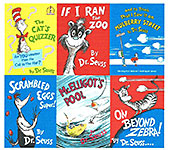
1.jpg)
2.jpg)
3.jpg)
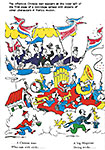
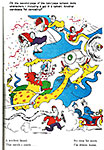
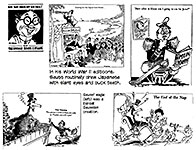
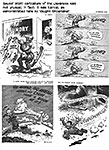
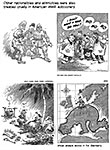
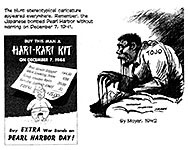


1.jpg)
2.jpg)
4.jpg)
5.jpg)
6.jpg)
7.jpg)
8.jpg)

9.jpg)
10.jpg)
11.jpg)
12.jpg)

13.jpg)
14.jpg)
15.jpg)
16.jpg)
17.jpg)
18.jpg)
19.jpg)
20.jpg)
21.jpg)
22.jpg)

